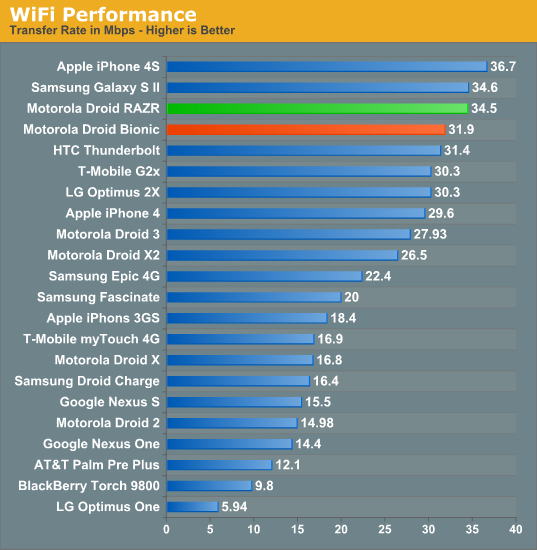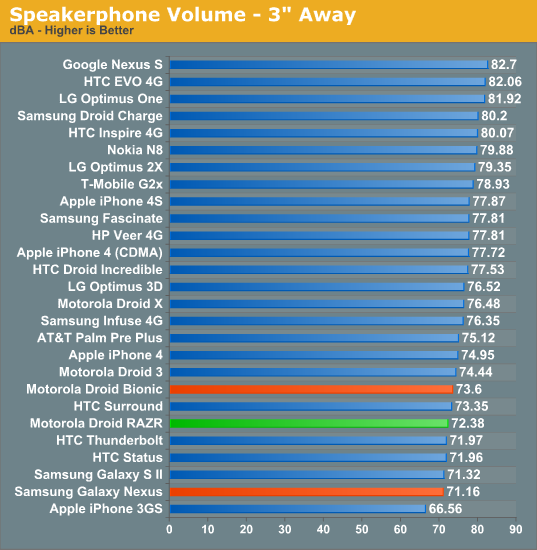Motorola Droid RAZR Review - A Better Clad Bionic
by Brian Klug on December 16, 2011 2:01 AM EST- Posted in
- Smartphones
- Droid
- LTE
- 4G
- Motorola
- Android
- Mobile
- Droid RAZR
- motorola droid RAZR
WiFi, GPS, Audio and Speakerphone
The RAZR uses a TI Wilink 7 series WL1285 combo chip for Bluetooth and WiFi, which is the same situation as the Bionic, unsurprisingly. WiFi is limited to 2.4 GHz and single spatial stream 802.11n, and I saw the RAZR negotiate a 65 Mbps (long guard interval) physical rate with my 20 MHz 802.11n wireless network. I found that range on the RAZR is totally on par with other smartphones I’ve used. Though the visualization at the top seems to be rather conservative with showing bars, if you go view the actual RSSI for WiFi (inside ##4636## and Wireless Information) you’ll see things are just fine. Bluetooth is 4.0 LE + EDR which is the latest bleeding edge.

Throughput on WiFi is pretty decent and just a tad faster than the Bionic. It’s possible the subtle software differences between the two account for this difference in throughput.
WiFi Hotspot
I had some issues with the RAZR’s WiFi hotspot that I didn’t encounter with the Bionic. Specifically, when using the hotspot with WPA2 enabled, clients would only be able to attach occasionally for a short period, or not at all. This initially posed lots of frustration when trying to do our WiFi hotspot battery life test, however disabling encryption entirely and running a public AP resulted in no instability.
You still can attach a maximum of 5 clients if you pay the extra fare to Verizon to enable tethering (which the device does check to see is provisioned), and on the whole this works well, just only with security set to open in my experience.
GPS
To the best of my knowledge, the RAZR is using the GPS system onboard MDM6600 and not from the TI Wilink 7 series combo chip. It’s a bit hard to nail down for sure, but I was able to confirm on the Bionic and it seems reasonable that the same applies here.
Like we’re used to seeing from that system, GPS locks are super fast even indoors and don’t pause or stutter at all. I didn’t have any issues with GPS and used the RAZR a few times with Google navigation without any hitch.
Audio + Speakerphone
First up in the audio department is speakerphone loudness, which we’ve been measuring for a while now using a USB sound level data logger while placing a test call to the local ASOS. The RAZR is on the quiet side which isn’t incredibly surprising considering the placement and constraints on the size of its acoustic chamber.

The other part of audio is of course call quality, and the RAZR isn’t different at all subjectively from the other Motorola phones on Verizon I’ve reviewed recently. As a reminder all calls go over 1x voice, and by default almost every device uses the EVRC coder, though you can change this to 13k in the programming menu and perceive a slight change in call quality. Noise cancellation features likewise remain the same, again courtesy of the three microphones onboard the RAZR.
The last important audio quality metric is what the device sounds like when playing back music. The Bionic used an ST-E 3.1 CPAC combo power management IC and audio codec, and the RAZR uses an ST-E 3.2 CPCAP. I’m embarrassed to admit it, but I only recently discovered how to change (read: disable) the DSP that Motorola has enabled on the RAZR by default (and ostensibly many other of their devices that have crossed my desk). Because I use Google Music, I rarely venture into the first party Music application, and it’s inside here that the settings lurk for DSP, which are by default enabled.
The background whine that I complained about on the Bionic is reduced but still faintly perceptible with sensitive IEMs on the RAZR. Though it is still present, it’s no longer as fatiguing and irritating as it was on the Bionic. I’m not sure whether that’s more a function of ST-E’s 3.2 (as opposed to 3.1) or something else, but it’s much better.
If you’re interested, I also ran a run of RMAA using an ASUS Xonar Xense sound card and line-in on the RAZR, Nexus S with VoodooSound, and a GSM Galaxy Nexus for comparison. The RAZR with all of the equalizer and DSP settings turned off actually isn’t bad at all, and though I’m not an expert at reading RMAA’s tea leaves, it has good noise figures and frequency response, and though noise takes off at the lower frequencies as our own Chris H. pointed out this less than ideal behavior is only 7% of the spectrum.










76 Comments
View All Comments
kishorshack - Friday, December 16, 2011 - link
That is an awesome phone, a request from all of usDo review it. The interesting part here would be running ICS on it :D
dj christian - Thursday, December 22, 2011 - link
Hope you were ironic. Well i've read alot of N9 reviews already but it would be nice if Anand would do one, just part from the usual Android and iOS sphere of lately.Araemo - Friday, December 16, 2011 - link
You mention you tested wifi hotspot with encryption off on this phone.. is that possibly why it bested the droid bionic's wifi hotspot battery life by so much? AES encryption could be a not-insignificant amount of the power draw when operating a secured wifi hotspot.IKeelU - Friday, December 16, 2011 - link
I think the phone would be way nicer without an edge that sticks out. It makes it look dated already, but there's probably a structural reason to have it there (or something).Also wtf is Apple doing to make 3g browsing last so damn long?!
PeteH - Sunday, December 18, 2011 - link
It must have something to do with that giant A5, because the iPhone 4 doesn't have nearly the same benefit.mr_thomas - Friday, December 16, 2011 - link
If you are going to put in iPhone comparisons in the benchmarks, etc., please do it across the board. It isn't helpful to see it in only a few places.introiboad - Tuesday, December 20, 2011 - link
I think they avoid it in browser benchmarks because Gingerbread doesn't support multithreaded rendering, and the comparison would be unfair. Don't take my word for it though.doobydoo - Tuesday, January 17, 2012 - link
There are only certain benchmarks which can be carried out on both Android and iOS, and on particular handsets. Everywhere where the benchmark could be carried out, they included it, which is as informative as they can be.RavnosCC - Friday, December 16, 2011 - link
Where's the comparison? HTC's Rezound has arguably much better hardware than the RAZR, and yet it's left out :(Plester - Friday, December 16, 2011 - link
I find the really big bezel and angled corners results in a down right odd and ugly looking phone, but taste is subjective...